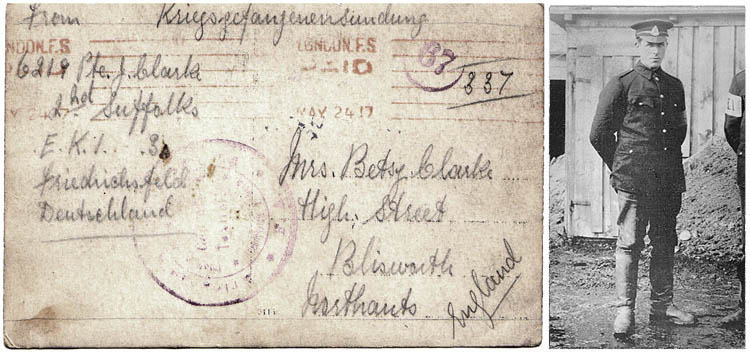
News print from c. 1915 - text recast for clarity.
|
Details for WWI Military Service - Blisworth |
|
|
Most of these entries are a result of communications with relatives of the soldiers |
|
|
J R Clarke |
John Robert Clarke served in D company 2nd Suffolk Regiment.
This regiment was part of the British Expeditionary Force who were sent to France and Belgium in WW1. The Battle
of Le Cateau occurred on 26 August 1914, after the British, French and Belgians retreated from the
Battle of Mons and set up defensive positions in a fighting withdrawal against the German
advance at Le Cateau-Cambrésis on 26 August 1914. In the morning on 26
August, the Germans arrived and heavily attacked the British. By the afternoon, the right, then left
flanks of the British, began to break. The arrival of the French cavalry protected the left flank. That night, the Allies withdrew to Saint-Quentin. Of the 40,000 Allied men fighting at Le Cateau, 7,812 were injured, killed or taken prisoner. Several British regiments had even disappeared from the rolls altogether. John Robert Clarke was then taken as a POW and subsequently imprisoned in the German POW camp in Doberitz, Latvia where he eventually died in 1917. The mailing of postcards back to ones family in Britain was evidently allowed at this camp. John Robert Clarke was an uncle to the late George Clarke of 11 Courteenhall Road, Blisworth. Information provided by a great nephew Tom Clarke. |
|
J T Clarke |
According to the war diary. Private Joseph Thomas Clarke
was building and repairing roads during WW1. He had survived the battle of the Somme which
had started in 1st July and in which thousands of soldiers were known to be killed,
wounded or listed as missing. He was killed on the 31st July in Carnoy whilst at a Royal
Engineers ammo dump by an enemy shell. The place where he was killed is only 44 miles away
from where his brother was captured by the Germans in 1914. Joseph Thomas Clarke was an uncle to the
late George Clarke of 11 Courteenhall Road, Blisworth.
The cemetery, where J T Clarke rests, was begun by French troops in October 1914, but Information provided by a great nephew Tom Clarke. |

News print from c. 1915 - text recast for clarity.

Postcard dated May 24, 1917 from J R Clarke to his mother in Blisworth

Bronfay Farm is located in a large tract of flat open farm land north of the
River Somme. Pictures by Tom Clarke.